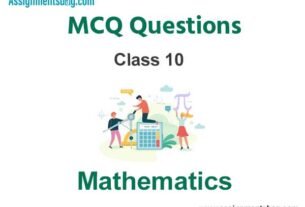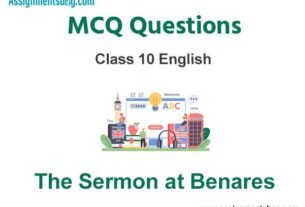Please refer to MCQ Questions Chapter 3 Money and Credit Class 10 Social Science with answers provided below. These multiple-choice questions have been developed based on the latest NCERT book for class 10 Social Science issued for the current academic year. We have provided MCQ Questions for Class 10 Social Science for all chapters on our website. Students should learn the objective based questions for Chapter 3 Money and Credit in Class 10 Social Science provided below to get more marks in exams.
Chapter 3 Money and Credit MCQ Questions
Please refer to the following Chapter 3 Money and Credit MCQ Questions Class 10 Social Science with solutions for all important topics in the chapter.
MCQ Questions Answers for Chapter 3 Money and Credit Class 10 Social Science
Question. Which among the following issues currency notes on behalf of the central government?
(a) State Bank of India
(b) Reserve Bank of India
(c) Commercial Bank of India
(d) Union Bank of India
Answer
B
Question. What percentage of their deposits as cash, do the banks in India keep with themselves?
(a) 20 percent
(b) 15 percent
(c) 12 percent
(d) 10 percent
Answer
B
Question. Rita has taken a loan of ` 7 lakhs from the bank to purchase a car. The annual interest rate on the loan is 14.5 per cent and the loan is to be repaid in 3 years in monthly instalments.
The bank retained the papers of the new car as collateral, which will be returned to Rita only when she repays the entire loan with interest.
Analyse the loan information given above,and point out which one of the following is the correct option that describes the above statements accurately.
(a) Mode of re-payment
(b) Terms of credit
(c) Interest on loan
(d) Deposit criteria
Answer
B
Question. Money is accepted as a medium of exchange because
(a) It is authorized by the government of India
(b) It is issued by the Reserve Bank of India
(c) It is legalised as a medium of payment in India
(d) All of these
Answer
D
Question. Find the Incorrect option
(a) Demand deposit share the essential features of money
(b) With demand deposit payments can be made without cash
(c) Demand deposits are a safe way of money transformation
(d) Demand deposit facility is like cheque
Answer
D
Question. Formal sources of credit do not include
(a) Banks
(b) Cooperatives
(c) Employers
(d) Both (a) and (b)
Answer
C
Question. When do people have the provision to withdraw money? Choose the most appropriate option from the following:
(a) They can withdraw money at the time of severe illness
(b) They cannot withdraw money before it reaches to it maturity level.
(c) They can withdraw money as and when they require
(d) Both (a) and (b)
Answer
C
Question. Terms of credit do not include:
(a) Bank deposits
(b) Interest rate
(c) Collateral
(d) Mode of repayment
Answer
A
Question. Which one of the following options is NOT correct about a typical Self-Help Group?
(a) It has 15-20 members
(b) It does not give a man its membership
(c) Its members usually belonging to one neighbourhood
(d) Saving per member varies in it.
Answer
B
Question. Money borrowed from banks and cooperative societies comes under which source of credit?
(a) Informal
(b) Formal
(c) Semi-Formal
(d) None of the above
Answer
B
Question. Find the correct option:
(a) Collateral is what pushes the lender in to a painful debt trap situation.
(b) Collateral is the amount that RBI gets from other banks.
(c) Collateral is an asset that the borrower owns and uses as a guarantee to a lender against the amount borrowed.
(d) Collateral does not include jewellery.
Answer
C
Question. In a self-help group most of the decisions regarding savings and loan activities are taken by which one of the following:
(a) Bank
(b) Members
(c) NGOs
(d) All of these
Answer
B
Question. What do people do with the extra cash in hand? Choose the most correct option from the following:
(a) They deposit it with one of the informal lenders
(b) They deposit it with an NGO
(c) They deposit it with the bank manager
(d) They deposit it with the banks by opening a bank account in their name.
Answer
D
Question. Arrange the following forms of currency according to their usage from oldest to recent use:
(i) Paper Currency
(ii) grain and cattle
(iii) coins
(iv) Net banking and digital payments
(a) (iii)—(iv)—(i)—(ii)
(b) (ii)—(iii)—(i)—(iv)
(c) (i)—(ii)—(iiii)—(iv)
(d) (iv)—(iii)—(ii)—(i)
Answer
B
Question. Bank deposits are also called ……………………. .
(a) Collateral
(b) Demand deposits
(c) Cheque
(d) Currency
Answer
B
Question. Rampur is an area where 80% people borrow money from the bank while 10% don’t borrow and the rest 10% take it from their friends, relatives or local moneylenders.
Where will Rampur be situated?
(a) In an Urban Region
(b) Semi-Urban area
(c) In a Rural region
(d) Capital of a country
Answer
A
Correct and Rewrite/ True-False
Question. Banks and cooperatives are informal sources of credit. State whether the statement is
Answer
False
Question. Double coincidence of wants is an essential feature of Barter system. State whether the statement is True or False. If false, correct the statement.
Answer
True
Fill in the Blanks
Question. ………………. is an asset that the borrower owns and uses as a guarantee until the loan is repaid to the lender.
Answer
Collateral
Assertion-Reason (A-R)
In each of following questions, a statemant of Assertion (A) is given followed by a corresponding statement of Reason (R). Select the correct answer to codes (a), (b) (c) or (d) as given below:
(a) Both (A) and (R) are true and (R) is the correct explanation of (A).
(b) Both (A) and (R) are true but (R) is not the correct explanation of (A).
(c) (A) is correct but (R) is wrong.
(d) (A) is wrong but (R) is correct.
Question. Assertion (A) : Not all the money that is deposited in the bank by the depositors is kept by the banks themselves.
Reason (R) : They use it to further extend loans to people, so that the difference between interest earned and interest given can be further invested and the chain will continue to go on.
Answer
(b)
Question. Explain the meaning of ‘Currency’.
Answer
Currency is the form of money: paper notes and coins.
Question. Give one reason that prevents a rural poor from getting a formal loan.
Answer
Lack of collateral
Question. Why do banks ask for collateral while giving loans?
Answer
Banks use collateral as a guarantee until the loan is repaid.

We hope you liked the above provided MCQ Questions Chapter 3 Money and Credit Class 10 Social Science with solutions. If you have any questions please ask us in the comments box below.


